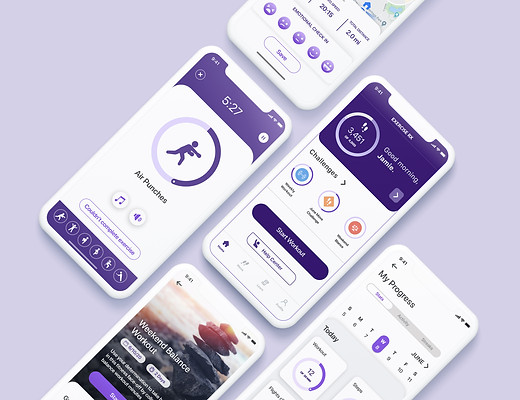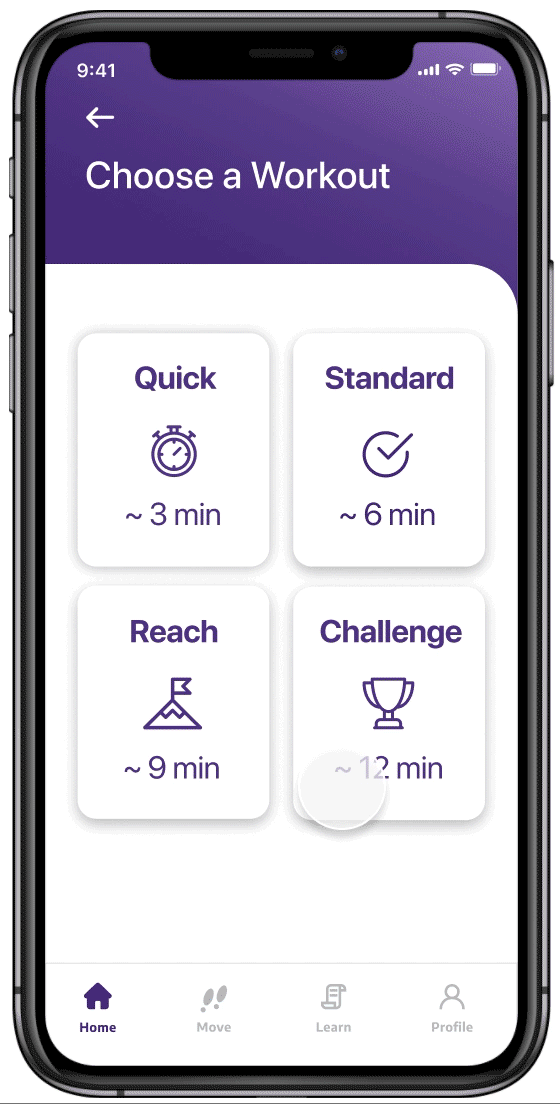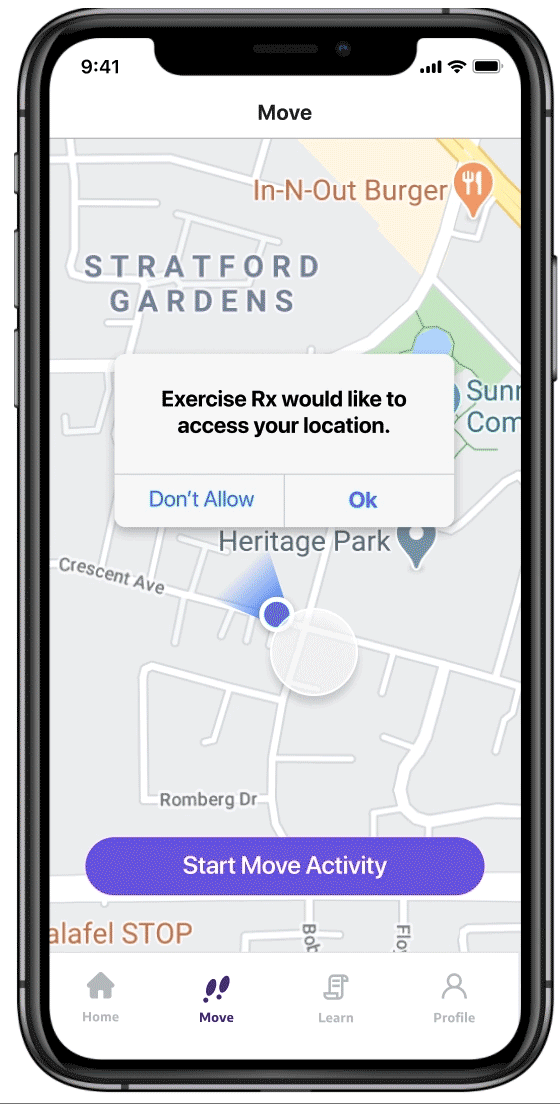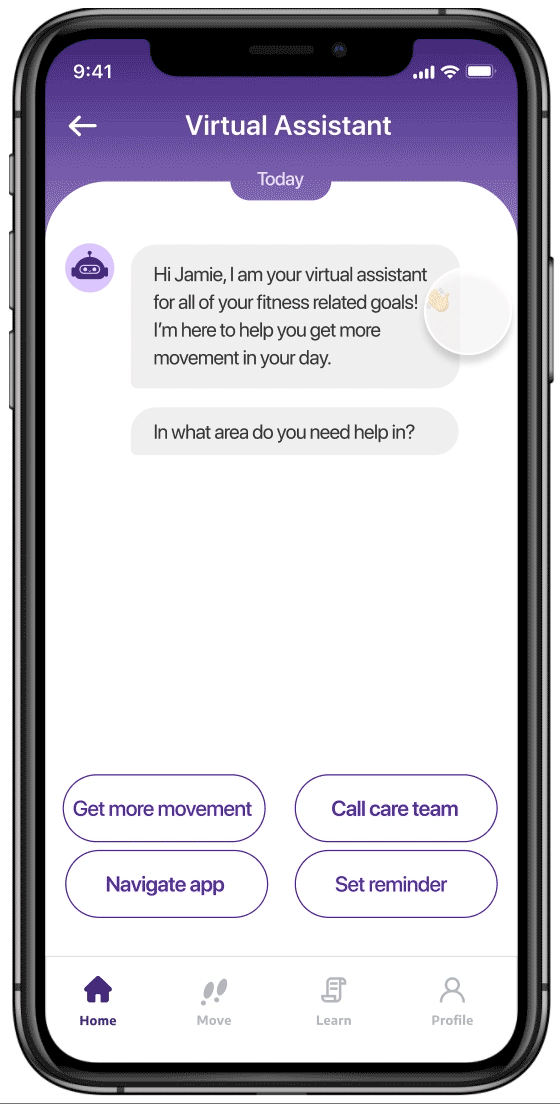

Exercise Rx
OVERVIEW
About the project
A sedentary lifestyle is a major underlying cause of death, disease, and disability that leads to about 2 million deaths per year. Currently, physical inactivity costs the US healthcare system $117 billion per year. The Sports Institute at the University of Washington approached my team and I to design a mobile app that supports sedentary patients in increasing movement in their daily lives through the use of physician feedback and monitoring as well as motivational support.
Our work led to the creation of a Northstar high-fidelity prototype and a Product Requirement Document outlining the importance and implementation of features. I am currently working with a developer to deliver the alpha version of the application to be tested with patients in Fall 2020.
My Role: UX Designer
-
Conducted behavior change methodology literature review
-
Lead exercise app competitive analysis
-
Moderated patient interviews
-
Own the design & implementation of the Exercise, Move and Challenges features
-
Low and high-fi prototype design
-
User flow, wireframes, and mockups
Tools:
Figma, Adobe Illustrator & Photoshop
Team:
Carrie Ding, Jenn Chan, Connor O'Toole
INITIAL CLIENT MEETING
Project Goals
After meeting with the stakeholder team that is part of the UW Sports Institute we came up with a list of project goals that the mobile app needed to achieve. Below are the four main goals:

Encourage Long-term Behavior Change
Help sedentary patients become more active and more engaged in their health.

Record & Remove Barriers to Exercise
To assist the behavior change process through understanding the patient experience & providing support.

Provide Physician Support & Intervention
To ensure the patient's safety, provide support & ensure adjust exercise intervention if needed.

Provide Exercises & Step Count Motivation
To be inclusive of the patient's limitations ranging from their physical ability to lifestyle.
THE SOLUTION
Excercise Rx Mobile App
The Exercise Rx app supports sedentary patients in increasing movement in their daily lives through the use of personalized workouts, behavior change interventions, and physician feedback and tracking.
This app will be applied throughout the University of Washington Medicine system and later integrated within the Epic healthcare software, to ensure a more connected experience between the patient and physician sides.

KEY FEATURES

Workouts
This feature provides patients with physical activities that are tailored to their needs while minimizing the amount of time needed to set up the workout.
Users can choose a bite-sized workout (3, 6, 9, 12 min) during their day to increase their movement. The feature also allows patients to report any problems they might encounter during their workout to ensure their safety.
Move
The Move feature provides variety in exercise and promotes physical exercise outside of the home through tracking patient’s walks, runs, and outings.
Users can track their outing using GPS and see a visualization of their route as well as distance, time, and average speed.


Challenges
The Challenges feature drives patient engagement
through the use of extrinsic motivation. It provides patients with timed challenges where they can challenge themselves or compete with others with the same baseline activity level.
This feature complements the more passive achievement motivation that the Streaks and Badges section provides.
Virtual Assistant
This feature aids in recording and assisting in problem-solving through barriers to exercise that patients encounter.
The virtual assistant can also provide support in-app navigation and features, as well as an easy way to contact the patient’s care team if needed.

Interactive prototype
RESEARCH
Identifying problem areas
The goal of our research was threefold & below are the research methods we utilized:
1. Understand the challenges sedentary individuals face from the patient and physicians sides
2. Learn how physicians support patients in getting more movement
3. Find a motivational intervention that is most successful within the realm of fitness

Literature Review
To determine the best behavior change interventions needed
.png)
Competitive Analysis
To understand the interventions of commerical fitness and PT apps

Patient Interviews
To understand patient needs and barriers to exercise

Physician Interviews
To learn about exercise intervention needs
PERSONAS
Understanding our audience
From our mixed methods research, we found that we had two types of sedentary individuals that may benefit from exercise interventions and may need more support depending on their background.
Patient A

-
Has a longer medical history, might be older (40-70 years old) and may visit a physician for an unrelated issue to exercise such a health condition (e.g. diabetes, arthritis) or pain
-
Lacks the knowledge that exercise & movement will improve their condition
-
Their general physician does not have the time to set up an exercise list of interventions that will improve their general health
-
May have limited abilities due to their health condition
Patient B

-
Has a shorter medical history or no prior health conditions, might be younger (25-40 years old), and may visit a physician only for their annual check-up
-
Lacks the knowledge that they are sedentary and may later develop serious medical conditions if their sedentary lifestyle persists
-
May be interested in exercise as a way to achieve a certain goal (e.g. lose weight, have less trouble to fall asleep, etc.)
RESEARCH FINDINGS
Needs & pain points
Needs
-
Customization and variety in exercises to stay engaged
-
Education within the realm of how to safely complete exercises
-
Stats and progress tracked accurately
-
Inclusive to patients with different ability levels and circumstances (e.g. neighborhood is unsafe to walk in)
Pain points
-
Cost and time are their greatest barriers to exercise
-
Don't know the effects of a sedentary lifestyle
-
Have trouble motivating themselves to exercise after reaching their short term exercise goal (e.g lose weight for a wedding)
-
Lose interest if not challenged
SELECTED FEATURES
Defining app functionalities
Stakeholder needs

-
Encourage long-term behavior change
-
Provide physician support
-
Record and remove barriers to exercise
-
Provide exercises & step count motivation
Research findings

-
Allow customization & variety
-
Provide accurate exercise & step tracking
-
Education about exercises & fitness
-
Support the needs of both sedentary personas and allow for more physician support for Persona A
JOURNEY MAP
Identifying use case
I compiled all of the data gathered from our research and designed an experience map showing our patient user journey through a first time and continuous app use depending on how much physician support they might need.
First time use

Continuous use

3. Challenges
IDEATION
Exploring ideas & opportunities
My team and I came up with six main features in addition to a patient app onboarding. Below is the feature list with the goals of each feature.
USER FLOW
I created a user flow to visualize the navigation of the app and present how the features relate together as a whole. I also designed an interactive prototype of the application and onboarding to illustrate the experience of using the app.

Home screen nav
Bottom nav

PROTOTYPE
Evaluation & revisions
My team and I performed 2 rounds of rapid prototyping, testing, and iteration with sedentary participants. As the designer on our team, I created the low to high fidelity prototypes. I also ensured that all features and functions flowed together seamlessly and assisted in running the majority of the usability tests.
My team and I utilized the Rapid Iterative Testing and Evaluation (RITE) method usability testing in our initial explorative phase to evaluate our ideas and afterward lead 5 hi-fi prototype usability tests. At the end of the tests, I incorporated participant feedback in our final design. Below is an analysis of our design choices within the main features.
Exercises
Move activity

Challenges

Virtual assistant
CONCLUSION
Limitations & next steps
With more time I would like to review the challenges and workout features as well as test our prototype with more patients that fall into the Patient A category.

Challenges Feature
Usability participants showed interest in collaborative challenges as a motivation for exercise over any other motivation type. They wanted to collaborate or compete with friends during real-time to finish challenges. We could not provide such a feature since the app is part of the UW Medicine system but would like to further collaborate with the hospital to see if we can support patient partnerships.
Workout Sequence
Time is the greatest barrier to exercise for sedentary individuals thus we designed timed exercises over rep-based ones for the Workout feature. Our usability tests showed that both Patient A & B liked the timed exercises, but the exercise sequence we created was only tested in situ with 3 Patient B participants. We would like to run in situ testing of the exercise list with Patient A participants to ensure that it would be fitting.

Type A Patients
Due to the COVID-19 pandemic, my team and I had more challenges recruiting a balanced mix of sedentary participants that fit the Patient A criteria. Due to this we only had 2/10 participants that fell into the Patient A category and were unable to test the exercise sequences in situ. As a next step, it would be beneficial to recruit more Patient A participants and test the prototype with them.
Impact
My team and I delivered a Northstar prototype of the application and a Product Requirements Document (PRD) that listed the features and subfeatures in order of importance, outlined their function, and any areas of future research and testing that should be done before implementation.
I am currently collaborating with a developer on the stakeholder team to create the alpha version of the application which features patient onboarding with baseline activity level calculation, step goals, and motivational nudges through notifications that will be tested Fall 2020 with patients from UW Medicine Sports Institute.
Additional discussion
Points not covered by this case study but could be worth discussing in person:
-
Initial design concepts, wireframes & sketches
-
Design considerations for Onboarding, Learn & Stats features
-
PRD feature prioritization
-
Exercise Rx Version 1 design features




